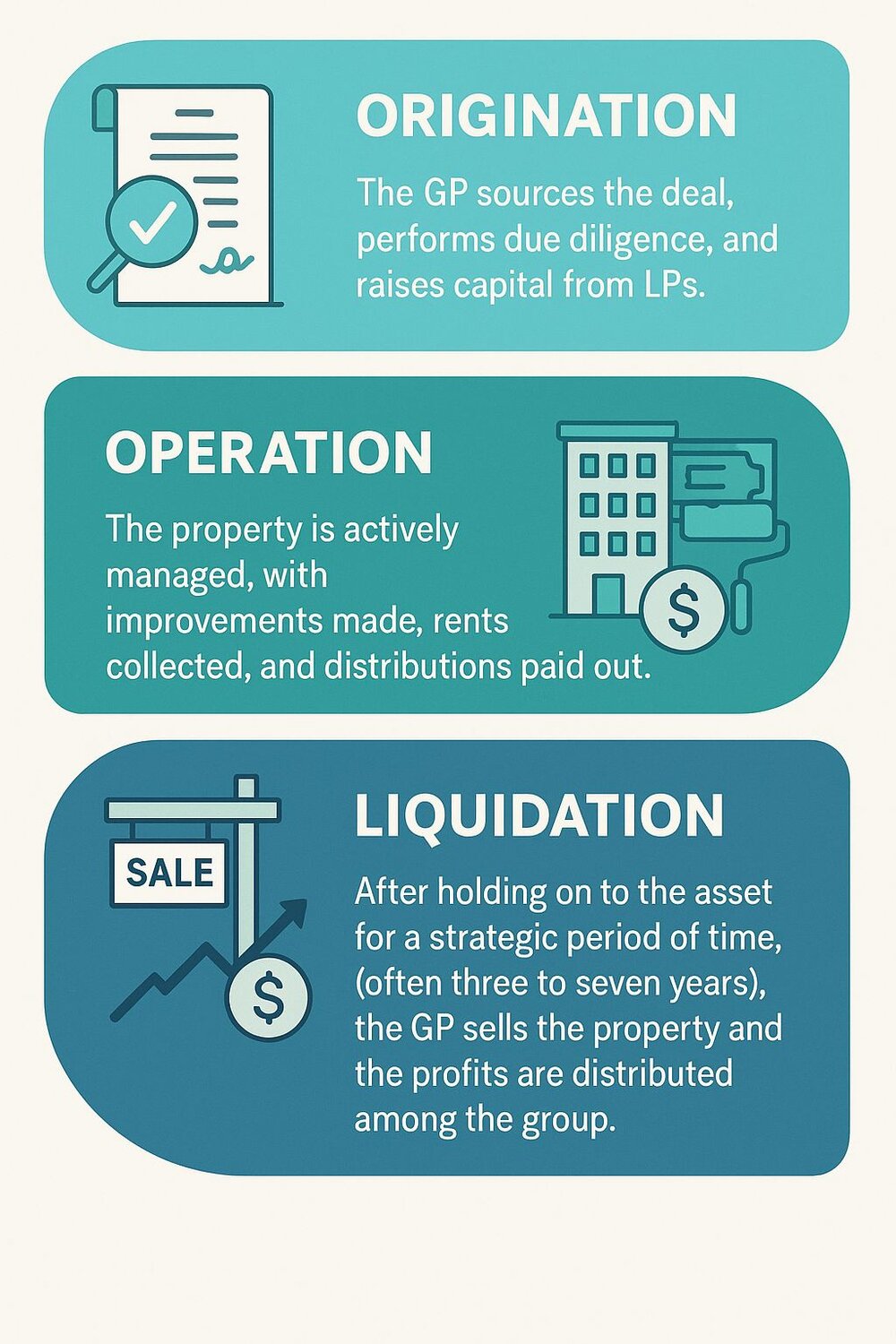What is Syndication in Commercial Real Estate?
Learn


Commercial real estate (CRE) syndication is opening the doors for a new generation of investors to access large, institutional-grade properties without needing to buy them outright.
Whether you’re new to the CRE world or looking to expand your portfolio, understanding how syndication works can give you a smart path into high-value deals. This guide explains real estate syndication in plain terms, so you can evaluate opportunities with clarity and confidence.
What is Real Estate Syndication?
So what exactly is a real estate syndicate, and how does it work? At its core, real estate syndication is a group investment model. Rather than a single investor purchasing a property, a group of investors pools their resources to acquire, manage, and eventually sell large commercial assets. This can include many different types of commercial real estate, including multifamily apartment complexes, office buildings, industrial parks, shopping centers, or even self-storage facilities.
Unlike direct ownership, where you’re the sole decision-maker (and fully responsible for management), syndication allows passive investors to share in the rewards while an experienced sponsor handles the heavy lifting. And while syndication and crowdfunding may seem similar, they’re not the same: crowdfunding usually involves smaller, publicly marketed deals, while syndication often happens through more targeted, private networks.
How Does Commercial Real Estate Syndication Work?
A typical syndication structure involves two main parties:
- The general partner (GP), also known as the sponsor, is responsible for identifying the opportunity, securing financing, managing the property, and overseeing the business plan.
- The limited partners (LPs), or passive investors, provide the majority of the capital but take on a passive role, trusting the GP to execute the strategy.
Syndication deals are typically structured as LLCs or LPs, limiting each investor’s liability to their initial contribution. The life cycle of a syndication real estate deal generally follows three key phases:

Key Players: General Partner vs. Limited Partner
The success of a syndication deal often comes down to the relationship between the GP and LPs.
The general partner (GP) is the active player - they handle deal sourcing, financing, renovations, leasing strategies, and overall asset management. They are compensated not only through their ownership stake but also via fees and profit splits, which reflect the time, effort, and expertise they bring.
The limited partners (LPs) are passive investors. They contribute capital, typically in exchange for a proportional share of the cash flow, tax benefits, and profits from the sale. LPs rely on the GP to execute the business plan and provide regular updates but don’t get involved in day-to-day operations.
In some cases, you might also encounter co-GPs or joint venture (JV) partners, who bring additional expertise or capital to help strengthen the deal.
How Returns Are Structured in Syndication
Before investing in a syndication deal, it’s important to understand how returns are structured. Typically, the deal offers a preferred return (usually between 6–8%) to LPs, meaning they receive this percentage of profits before the GP takes a share.
Beyond this threshold, profits are often split according to a waterfall structure, which incentivizes the GP to outperform. For example, after LPs receive their preferred return, additional profits might be split 70/30 (LP/GP) up to a certain hurdle, and beyond that, shift to 60/40 to reward exceptional performance.
Imagine a syndication deal where limited partners invest $1 million total, and the property generates annual profits of $100,000. With an 8% preferred return, the first $80,000 goes to the LPs. If the profits exceed that, the remaining $20,000 might be split 70/30 between LPs and the GP. If profits surpass additional hurdles, the split could adjust again - say, to 60/40 - giving the sponsor an extra push to maximize investor gains.
Most deals offer monthly or quarterly distributions, creating a steady cash flow during the investment period.

Types of Commercial Properties Often Syndicated
Syndication deals span a wide range of commercial real estate assets. Commonly syndicated property types include:
- Multifamily apartment buildings
- Office towers and corporate campuses
- Retail centers and shopping plazas
- Industrial warehouses and logistics hubs
- Self-storage facilities
Each asset class comes with its own risk profile, management needs, and market dynamics, so be sure to consider how to align your investment goals accordingly.
Benefits of Commercial Real Estate Syndication
For CRE investors, the benefits of syndication make it an appealing prospect offering several potential benefits for long-term investors.
- Access to Larger, Higher-Quality Deals: By pooling capital, investors can access properties that would typically be out of reach individually - often Class A or institutional-grade assets. This opens the door to deals backed by strong fundamentals, premium locations, and professional management teams, which can improve long-term performance and reduce risk.
- Passive Income Potential: LPs enjoy a hands-off investment experience, earning income and appreciation without the responsibilities of active management. With the GP overseeing operations, investors can focus on their broader financial goals while enjoying regular cash flow and eventual profit from the sale.
- Tax Advantages: Syndicated deals can provide valuable tax benefits, including depreciation deductions, mortgage interest write-offs, and, in some cases, the potential for 1031 exchanges. These benefits can improve after-tax returns and help investors manage their tax liabilities more efficiently.
- Portfolio Diversification: Syndication allows you to spread your capital across multiple markets, property types, and strategies, reducing overall portfolio risk. Diversification helps protect against localized market downturns and gives investors access to a range of opportunities they might not achieve on their own.
- No Landlord Duties: With the GP handling operations, LPs don’t need to worry about tenant calls, repairs, or day-to-day management. As a result, investors can enjoy the financial benefits of real estate ownership without the time-consuming headaches of being a hands-on landlord.

Common Risks and Considerations
Like any investment, real estate syndications come with risks that investors should understand upfront.
- Illiquidity: Most syndications have multi-year hold periods, meaning your capital is locked up until the property is sold.
- Capital Calls: Unexpected renovation costs or operational overruns may require additional capital from investors.
- Market Risk: Shifts in local market conditions, interest rates, or tenant demand can impact returns.
- Sponsor Risk: The GP’s experience, transparency, and execution are critical - a poor sponsor can derail even the best-looking deal.
- Fee Structures: Syndications involve various fees (acquisition, management, disposition), so it’s essential to understand how they affect overall returns.
How to Evaluate a Real Estate Syndication Opportunity
Before investing, take time to ask questions like:
- What is the sponsor’s track record and reputation?
- Does the business plan make sense given the property, market, and financials?
- Are the projected returns reasonable and clearly explained?
- What are the risks, and how are they mitigated?
Review the pitch deck or offering documents closely—especially the underwriting, projected returns, and market assumptions.
Additionally, most syndications are offered under 506(b) or 506(c) regulations, which define who can participate. 506(b) offerings allow up to 35 non-accredited investors and unlimited accredited investors but require a pre-existing relationship, while 506(c) offerings are limited to accredited investors only but can be publicly advertised. Knowing the difference helps you understand who qualifies to join each deal.

Where to Find Syndication Deals
Syndication opportunities can be found through:
- Online platforms like CrowdStreet, RealtyMogul, and Fundrise
- Local sponsors or boutique firms with established track records
- Real estate investor meetups, conferences, or referrals from your network
Remember: 506(c) offerings can be publicly promoted, while 506(b) deals require a prior relationship with the sponsor.
As always, do your due diligence and use trusted resources to carefully review each opportunity.
Ready to Explore CRE Opportunities?
With the right knowledge and preparation, syndication can be a powerful addition to your investment strategy. Whether you’re a first-time investor or aiming to scale your portfolio, Crexi Intelligence can help you navigate the commercial real estate market with data-driven insights and smarter deal analysis.









